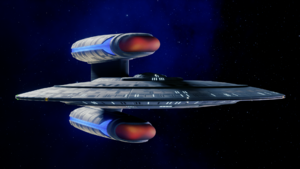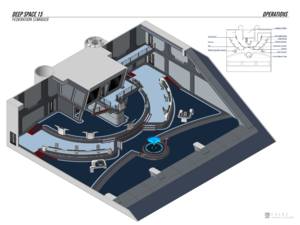Difference between revisions of "Olympia Station"
CrimsonTacit (talk | contribs) m |
CrimsonTacit (talk | contribs) |
||
| Line 61: | Line 61: | ||
=== Command and Control === | === Command and Control === | ||
[[File:StationOperations.png|alt=Station Operations and the four Docking Control facilities share an identical layout, with an office for the commanding officer (in the case of Station Operations) or the Dockmaster (for the Docking Control Facilities).|thumb|Station Operations and the four Docking Control facilities share an identical layout, with an office for the commanding officer (in the case of Station Operations) or the Dockmaster (for the Docking Control Facilities).]] | |||
Station Operations is located at the base of the upper command module on top of the spacedock centered on Door 12. This facility is heavily shielded and its large viewport can even be sealed off with a sheet of ablative armor when necessary. It is from here that all approach and docking requests are handled, before being handed off to one of the docking control centers. Tactical functions are also controlled from here, and it is the equivalent of the main bridge of a starship. This facility is identical to the four docking control complexes, and command of the station can be handled from any of them in an emergency. | Station Operations is located at the base of the upper command module on top of the spacedock centered on Door 12. This facility is heavily shielded and its large viewport can even be sealed off with a sheet of ablative armor when necessary. It is from here that all approach and docking requests are handled, before being handed off to one of the docking control centers. Tactical functions are also controlled from here, and it is the equivalent of the main bridge of a starship. This facility is identical to the four docking control complexes, and command of the station can be handled from any of them in an emergency. | ||
Revision as of 03:55, 5 October 2023
Deep Space 20, code-named Olympia Station, is a Federation Spacedock-class starbase located in the Olympia system on the extreme rimward trailing edge of Federation space near Sheliak, Tholian and Tamarian space. Named along with the system it resides in for the ill-fated exploratory vessel USS Olympia, this starbase serves a similar purpose to Deep Space 17: a waystation for long-range missions beyond Federation space.
Operations
Assigned to the Fourth Fleet, Olympia Station supports the following operations in the Olympia Sector:
- Service exploratory starships embarking on and returning from missions outside of Federation space.
- Conduct scientific research on nearby systems and identify sites for future Federation colonization.
- Monitor the expansion of the Sheliak Corporate and Tholian Assembly.
- Maintain diplomatic relations with the Children of Tamar.
Exploratory Support
First and foremost, Olympia Station supports Federation and Starfleet vessels heading into deep space, both with physical engineering and logistics support and through sensor and communications functions. Olympia Station is the last starbase any vessel would be able to receive repairs or fuel from before heading towards the galactic edge or deeper into the Alpha Quadrant. It's also a terminus (for now) of the subspace relay network, making it the last place where anyone could hope to have synchronous or semi-synchronous conversations with superiors, friends, or family across the Federation. The station's massive computer cores are also used to collate and process exploratory information collected by missions in the area.
Scientific Research
Olympia Station conducts its own program of scientific research in neighboring systems and across the Olympia Sector, with its support ship, the Nellie Bly, and its small fleet of runabouts. Primarily, the aim is to identify planets for future colonization, but stellar mapping and general exploration are secondary priorities.
Monitoring Regional Powers
While neither the Sheliak Corporate or the Tholian Assembly are actively hostile to the Federation, they are considered to be possible threats by Starfleet Intelligence due to their xenophobia. The Federation maintains limited diplomatic relations with these races, and one of the functions of Olympia Station is to monitor the space beyond their territory to look for signs of aggression or expansionism.
Diplomatic Relations
Many species maintain consulates on Olympia Station, both Federation members and other powers, as they wish to be kept apprised of any first contacts made on this remote frontier. In particular, however, Olympia Station has been tasked with supporting and maintaining diplomatic relations with the Children of Tamar, promoting joint operations where possible. The following species have consulates on Deep Space 20:
- Tamarians
- Tellarites
- Humans
- Vulcans
- Andorians
- Betazoids
- Denobulans
- Klingons
The Federation also maintains a diplomatic mission on the station, which works in conjunction with the station's commander and Starfleet to provide consular services to Federation citizens.
Support Vessels
Olympia Station is primarily supported by the USS Nellie Bly, a Challenger-class scout. The Bly performs scouting functions around the Olympia system, as well as diplomatic courier missions to and from Tamarian space. The Bly has her own commanding officer, though senior starbase personnel will act as mission commanders when necessary.
All twelve of the station's runabouts are Arrow-class vessels, which are kept in a constant rotation to support exploratory missions in the surrounding sector, with two of the twelve typically held in reserve for urgent missions and for station defense. Out in the field, these small starships typically operate with a crew of twelve on six to eight-week missions.
Configuration
Compared to the stock Spacedock-class station, Olympia Station has been modified many times over its nearly eighty years of life. It has modern systems and its docking facilities have been reworked to handle 25th-century starships, though these modifications did not include widening the upper bay doors, so the largest vessels must vie for space in the single large docking bay in the lower docking module.
Command and Control
Station Operations is located at the base of the upper command module on top of the spacedock centered on Door 12. This facility is heavily shielded and its large viewport can even be sealed off with a sheet of ablative armor when necessary. It is from here that all approach and docking requests are handled, before being handed off to one of the docking control centers. Tactical functions are also controlled from here, and it is the equivalent of the main bridge of a starship. This facility is identical to the four docking control complexes, and command of the station can be handled from any of them in an emergency.
Docking Facilities
The upper spacedock has a four-armed docking column that supports up to eight midsized starships--midsized by 25th century terms, anyway. The space doors at 90-degree angles along the rim of the upper dome leading into the bay are labeled 12, 34, 56, and 78, as they allow access to mooring points 1 & 2, 3 & 4, and so on, like a clock face. Halfway between each set of space doors is a band of six shuttle bays that also provide access to the interior of the bay, each with a docking control complex taking up the center; each docking control complex is responsible for the quadrant of space it faces. The upper docking module can only accommodate ships up to 245 meters wide, as the doors are 250 meters wide.
As with Gateway Station and the Starfleet Museum, Olympia Station's arboretum module was retrofitted to serve as a single large berth capable of servicing a single Odyssey-class heavy explorer. This bay, in the middle third of the lower module, is labeled 9, and is 1,200 meters deep, 600 meters wide, and 200 meters tall. Below this bay are twelve large hangers.
The habitation modules above and below the lower docking module each have four shuttlebays. Runabouts, shuttles, and small civilian vessels have access to these dozens of hangers at various levels across the station, while larger vessels generally orbit the station when they don't need service.
Arboretum
In its original configuration, the lower docking module was dominated by a large arboretum that took up the upper two-thirds of the module, with the station's travel core running down the middle. Because of the addition of a large bay for an explorer-type vessel in this area, the arboretum has been shrunk substantially to take up the top third of of the module, but like in other new facilities, its use of holographic technology makes it look just as large as it did before. The travel column continues down the center of the arboretum, but takes a horizontal path over the docking bay, before proceeding down again, and then back toward the center of the station under the docking bay.
History
The Olympia system has been home to an automated Starfleet deuterium refinery since the late 2370s, but plans for an eventual starbase to coordinate long-range exploration of the Alpha Quadrant were canceled during the Romulan Evacuation Mission. These plans never resumed due to Starfleet's inward-looking focus throughout the 2380s and 2390s. In 2400, the Fourth Fleet revived these plans. With the Spacedock-class Starbase Bravo recently replaced by a new Guardian-class station, Fourth Fleet Command decided to relocate the original Starbase Bravo to the Olympia System. During a year-long process, the station was refit and towed across Federation space to its new location. It was formally recommissioned in mid-2401, with Arcturus Squadron becoming the first exploratory group to call it home.
Notable Crew
Commanding Officers
In-Play
- Olympia Station is a flag station command assigned to Admiral Liam Dahlgren, but members may feature it in their stories in accordance with Section 4 of the Command Policy.
- Similar to Deep Space 17, Olympia Station is a waystation on one of the Federation's most distant frontiers. It is intended to fuel, supply, and repair ships for long missions outside of Federation space. It is approximately 300 light-years from Starbase Bravo, a two-week journey at Warp 9.99, and 128 light-years from Avalon Fleet Yards, a six-day journey at Warp 9.99. Slower ships would take weeks or months to reach the station.
- There are few direct threats to Olympia Station, as the Tamarians are friendly to the Federation and the Sheliak are uninterested in dealing with them. The Tholians can be a bit of a wildcard, though.
- Compared to other Starfleet starbases, Olympia Station has a lower civilian population, as it's not on a major trade route—at least not yet, as that will change when new colonies start to emerge.

